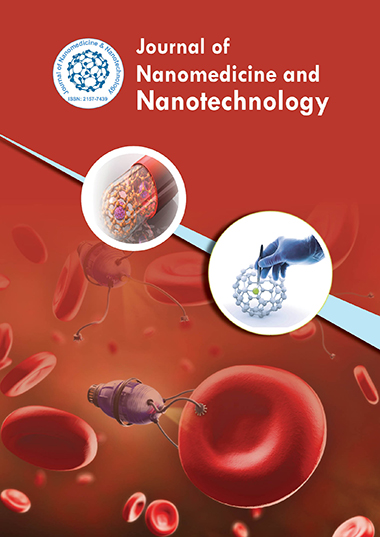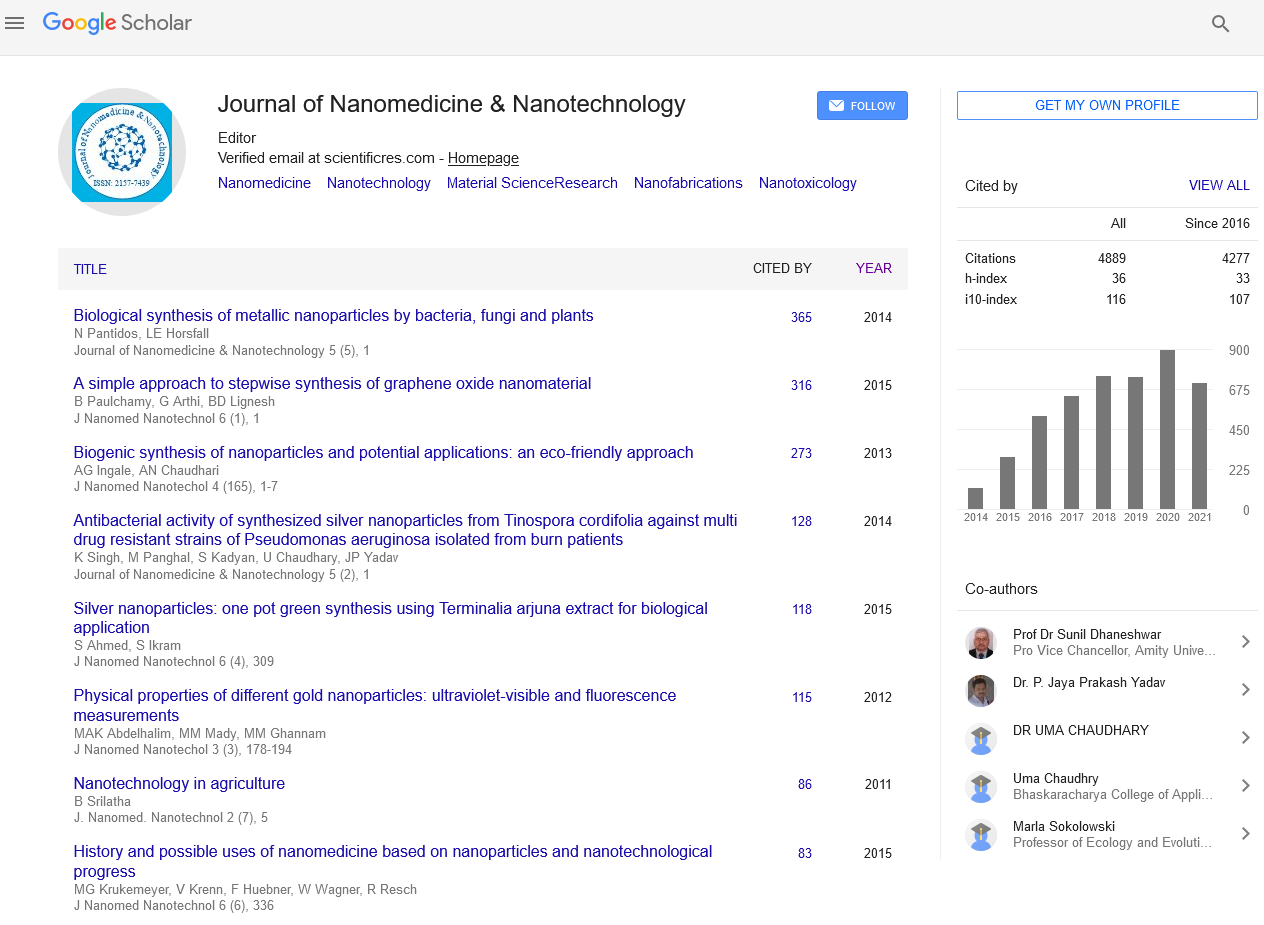Indexed In
- Open J Gate
- Genamics JournalSeek
- Academic Keys
- JournalTOCs
- ResearchBible
- China National Knowledge Infrastructure (CNKI)
- Scimago
- Ulrich's Periodicals Directory
- Electronic Journals Library
- RefSeek
- Hamdard University
- EBSCO A-Z
- OCLC- WorldCat
- SWB online catalog
- Virtual Library of Biology (vifabio)
- Publons
- MIAR
- Scientific Indexing Services (SIS)
- Euro Pub
- Google Scholar
Useful Links
Share This Page
Journal Flyer

Open Access Journals
- Agri and Aquaculture
- Biochemistry
- Bioinformatics & Systems Biology
- Business & Management
- Chemistry
- Clinical Sciences
- Engineering
- Food & Nutrition
- General Science
- Genetics & Molecular Biology
- Immunology & Microbiology
- Medical Sciences
- Neuroscience & Psychology
- Nursing & Health Care
- Pharmaceutical Sciences
Editorial - (2024) Volume 15, Issue 6
Design of High-Performance Nanostructured Electrode Materials for Lithium-Sulfur Batteries
Alrik Forslund*Received: 02-Nov-2024, Manuscript No. jnmnt-24-28192; Editor assigned: 05-Nov-2024, Pre QC No. jnmnt-24-28192 (PQ); Reviewed: 20-Nov-2024, QC No. jnmnt-24-28192; Revised: 25-Nov-2024, Manuscript No. jnmnt-24-28192 (R); Published: 30-Nov-2024, DOI: 10.35248/2157-7439.24.15.757
Abstract
Lithium-sulfur (Li-S) batteries are considered one of the most promising candidates for next-generation energy storage devices due to their high theoretical energy density and low cost. However, their practical application is limited by several issues, including poor cycle stability, low conductivity of sulfur, and the dissolution of lithium polysulfides during discharge. Recent advancements in nanotechnology have introduced nanostructured materials as a solution to enhance the performance of Li-S batteries. These materials are designed to improve the conductivity of sulfur and confine the polysulfides within the cathode to mitigate the loss of active materials. In this article, we review the recent progress in the design of nanostructured electrode materials for Li-S batteries, focusing on their role in enhancing electrochemical performance, cycle life, and energy efficiency. Key strategies for developing high-performance nanostructured electrodes are discussed, including the use of carbon-based materials, metal oxides, and nanocomposites. Furthermore, the challenges and future directions for the optimization of these materials are also explored.
Keywords
Lithium-sulfur batteries; Nanostructured electrodes; Cycle stability; Sulfur conductivity; Lithium polysulfides; Carbon-based materials; Nanocomposites
INTRODUCTION
Lithium-ion batteries (LIBs) have dominated the energy storage market for several decades, but they are reaching their theoretical energy density limits, prompting the search for alternative energy storage systems. Lithium-sulfur (Li-S) batteries have attracted significant attention due to their high theoretical energy density (~500 Wh/kg), which is more than five times higher than that of conventional lithium-ion batteries. Additionally, sulfur is abundant, environmentally friendly, and cost-effective, making Li-S batteries an attractive option for large-scale energy storage. However, the commercialization of Li-S batteries is hindered by several critical issues: (1) the low conductivity of sulfur (~5 × 10⻲ S/cm), (2) the dissolution of lithium polysulfides (LiPSs) into the electrolyte, which leads to the loss of active material and capacity fading, and (3) the poor cycle stability of sulfur cathodes due to volume expansion during charge/discharge cycles. To address these challenges, researchers are exploring the use of nanostructured materials for Li-S battery electrodes. Nanostructured materials offer several advantages, including high surface area, enhanced conductivity, and the ability to provide structural stability. These materials also facilitate better confinement of polysulfides and improve the electrochemical performance of the cathode and anode. In this review, we focus on the design and development of high-performance nanostructured electrode materials for Li-S batteries, which can potentially overcome the limitations of traditional sulfur cathodes and pave the way for the commercialization of Li-S batteries [2].
NANOSTRUCTURED CATHODE MATERIALS FOR LI-S BATTERIES
The sulfur cathode in a Li-S battery is typically composed of elemental sulfur mixed with a conductive carbon matrix. However, due to the insulating nature of sulfur and the polysulfide dissolution problem, the performance of conventional sulfur cathodes is limited. Nanostructured cathode materials aim to address these challenges by enhancing the conductivity of sulfur and improving the retention of lithium polysulfides within the cathode [3].
Carbon-based Nanomaterials
Carbon nanomaterials, including graphene, carbon nanotubes (CNTs), and porous carbon, are widely used as conductive matrices in Li-S batteries. These materials provide high surface area and excellent electrical conductivity, which help to improve the overall performance of the cathode. For instance, graphene-based materials can form a conductive network around sulfur, facilitating electron and ion transport. Carbon nanotubes and mesoporous carbons also serve to improve the structural integrity of the cathode, preventing the polysulfide dissolution and mitigating the volume change during cycling. Additionally, carbon nanomaterials can be engineered to create hierarchical porous structures, which provide more reaction sites and better confinement of polysulfides [4].
Metal Oxide Nanomaterials
Another promising approach involves the incorporation of metal oxide nanoparticles into the sulfur cathode. These materials not only improve the conductivity of the cathode but also act as effective polysulfide hosts. For example, TiOâ??, SnOâ??, and MoOâ?? have been investigated for their ability to adsorb lithium polysulfides and prevent their dissolution into the electrolyte. The metal oxide particles interact with polysulfides through chemical bonding or physical adsorption, helping to trap and stabilize them within the cathode. Additionally, these materials often have high surface areas and porosity, which allow for better sulfur loading and enhanced electrochemical performance.
Conductive Polymers
The use of conductive polymers in combination with carbon-based materials is also being explored. Polymers such as polypyrrole (PPy), polyaniline (PANI), and poly (3,4-ethylenedioxythiophene) (PEDOT) have been shown to improve the conductivity of the sulfur cathode while also serving as a barrier to polysulfide dissolution. These conductive polymers can interact with sulfur and lithium polysulfides to form stable composites that prevent active material loss and improve cycle stability [5].
Nanostructured Anode Materials for Li-S Batteries
The performance of the anode is equally important in determining the overall energy density and cycle stability of Li-S batteries. While sulfur is used as the cathode material, the anode typically consists of lithium metal or graphite. Lithium metal anodes offer the highest theoretical capacity, but they suffer from dendrite formation during cycling, which can lead to battery short-circuiting and safety concerns. Nanostructured materials are being used to address these challenges and enhance the performance of the anode.
Nanostructured Lithium Metal Anodes
One approach to improving the performance of lithium metal anodes is the use of nanostructured lithium. For instance, nanoporous lithium or lithium nanowires can help to reduce dendrite formation by providing a more uniform distribution of lithium ions. These nanostructured lithium anodes also offer a larger surface area for lithium-ion deposition, improving cycling efficiency and stability. Furthermore, protective nanocoatings such as solid electrolyte interphase (SEI) layers can be applied to the surface of the lithium anode to prevent dendrite growth and enhance the stability of the anode [6].
Graphene and CNT-based Anodes
For non-lithium metal anodes, graphene and carbon nanotubes (CNTs) have been used to enhance the conductivity and structural integrity of the anode. These materials facilitate the uniform deposition of lithium ions, preventing the formation of dendrites and enhancing the cycling stability of the anode. In addition, they can provide flexibility to accommodate the expansion and contraction of the anode material during cycling, thus improving the overall performance of the battery [7].
Nanocomposites for Li-S Batteries
Nanocomposite materials, which combine different nanomaterials into a single structure, have emerged as a powerful strategy to enhance the performance of Li-S batteries. By integrating carbon-based materials, metal oxides, and conductive polymers, nanocomposites can provide synergistic effects that improve the conductivity, stability, and sulfur retention in the cathode.
Carbon-Metal Oxide Nanocomposites
The combination of carbon-based materials and metal oxides has been widely explored for the development of high-performance cathodes. These composites take advantage of the excellent conductivity of carbon and the polysulfide-adsorbing properties of metal oxides. By optimizing the ratio of carbon to metal oxide, researchers can design composite materials that offer enhanced electrochemical performance, higher sulfur loading, and improved cycle stability.
Carbon-Polymer Nanocomposites
The combination of carbon-based materials with conductive polymers has also shown promise for Li-S batteries. These nanocomposites offer both high conductivity and effective polysulfide trapping, leading to improved cycle life and energy efficiency. For instance, the incorporation of polypyrrole into carbon-based electrodes has been shown to enhance the electrochemical stability and sulfur retention, thereby improving the overall performance of Li-S batteries [8].
CHALLENGES AND FUTURE DIRECTIONS
Despite the significant progress in the development of nanostructured materials for Li-S batteries, several challenges remain. One of the main issues is the scalability of the fabrication techniques for these nanostructured materials. While laboratory-scale synthesis has shown promising results, large-scale production of these materials with consistent quality and performance is still a challenge [9]. Additionally, the interfacial issues between the sulfur cathode and the electrolyte, as well as the poor cycling stability of lithium metal anodes, need to be addressed to improve the commercial viability of Li-S batteries. Future research efforts will likely focus on developing more efficient nanostructured materials that can enhance the overall electrochemical performance of Li-S batteries, improve cycle stability, and minimize the dissolution of polysulfides. Furthermore, the integration of solid-state electrolytes and advanced electrolyte formulations will be crucial to overcoming the inherent limitations of conventional liquid electrolytes and enhancing the safety and stability of Li-S batteries [10].
CONCLUSION
The design of high-performance nanostructured electrode materials has shown great promise in overcoming the key challenges faced by lithium-sulfur batteries. By improving the conductivity of sulfur, trapping polysulfides, and enhancing the structural stability of the electrodes, nanostructured materials have the potential to revolutionize the performance of Li-S batteries. Continued advancements in nanomaterial’s and electrode design are expected to pave the way for the commercialization of Li-S batteries, which could provide a highly efficient and cost-effective solution for energy storage in the future.
REFERENCES
- Lukyanov, A N, Torchilin, V P. Micelles from lipid derivatives of water-soluble polymers as delivery systems for poorly soluble drugs. Adv Drug Deliv Rev. 2016; 56(9): 1273-1289.
- Ghasemiyeh P, Mohammadi-Samani S. Solid lipid nanoparticles and nanostructured lipid carriers as novel drug delivery systems: Applications, advantages and disadvantages. Pharm Sci Res. 2018; 13(4): 288-303.
- Ekambaram P, Abdul AB. Anticancer efficacy of solid lipid nanoparticles loaded with 5-fluorouracil and its hydrophobic derivative: In vitro and in vivo analysis. Eur J Pharm Sci. 2016; 88:178-185.
- Safarzadeh M, Hajialyani M, Nematollahi A, Roshan, M K, Rezaee R. The potential role of nano-curcumin as an anti-inflammatory agent in rheumatoid arthritis. J Cell Biochem. 2018; 119(2):1015-1021.
- Kaminskas, L M McLeod, V M Ryan, G M Kelly, B D Haynes, J M Williamson et al . Pulmonary administration of a doxorubicin-conjugated dendrimer enhances drug exposure to lung metastases and improves cancer therapy. J Control Release. 2017; 268:147-158.
- Longley, D B, Johnston, P G. Molecular mechanisms of drug resistance. J Pathol. 2020; 205(2): 275-292.
- Prabhakar, Xu, L An, D Qian, S West, A C. Nanomedicine as an Emerging Platform for Metabolic Therapy in Cancer. Frontiers in Oncology. 2021: 11: 1622.
- Torchilin, V P. Multifunctional, stimuli-sensitive nanoparticulate systems for drug delivery. Nat Rev Drug Discov. 2018;13(11): 813-827.
- Kratz, F. Albumin as a drug carrier: design of prodrugs, drug conjugates and nanoparticles. Journal of Controlled Release. 2018; 132(3): 171-183.
- Vallet-Regi M, Colilla M, Izquierdo-Barba I, Manzano M. Mesoporous silica nanoparticles for drug delivery: current insights. Molecules. 2019; 24(2):247.
Indexed at, Google Scholar, Crossref
Indexed at, Google Scholar, Crossref
Indexed at, Google Scholar, Crossref
Indexed at, Google Scholar, Crossref
Indexed at, Google Scholar, Crossref
Indexed at, Google Scholar, Crossref
Citation: Alrik F (2024) Design of High-Performance Nanostructured Electrode Materials for Lithium-Sulfur Batteries. J Nanomed Nanotech. 15: 757.
Copyright: ©2024 Alrik F. This is an open-access article distributed under the terms of the Creative Commons Attribution License, which permits unrestricted use, distribution, and reproduction in any medium, provided the original author and source are credited.


